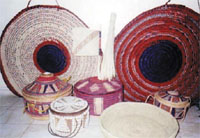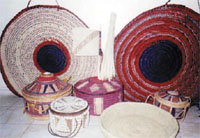
Al- Khoos, a traditional handicraft at heart [Archives:2004/739/Last Page]
May 20 2004
 |
Yemen Times Staff
Aden Bureau
Traditional handicrafts are virtually pure artistic expression practiced by certain groups of simple people in the community. They are closely tied to the civilization and progressive development of nations and peoples, thereby such activity is shaping natural expansion for the immense creative accomplishments and scientific discoveries of today's world. Accordingly, to find clues to any level the development of a certain nation, we should have cognizance of the varieties of its folklore and arts and crafts.
Our country has a broad scope of popular heritage that is characterized by a particular tone distinguished by the rest of other crafts in the Arab World. For this reason our social markets are fully decorated with varieties of Yemeni handicrafts under the existing circumstances of intense competition of new and modern products. As a matter of fact, Yemen possesses a considerable number of distinct handicrafts. There is a race against time to save them, while a few have disappeared and most are being influenced by new domestic commodities mixed with a sense of modernity, causing the loss of the artistic essence of the folkloric heritage of Yemen.
Nevertheless, many crafts are attached fact to a great number of skilled hands, maintaining the Yemeni originality. Shabwa has its peculiarities of having some distinguished conventional activities in general and Wadi Yesh-bom (ASSAID District) in particular, wherein various traditional handicrafts occupy a distinguished status, such that some families depend on them for their livelihood.
One such craft is Al-Khoos, or Al-Azef. It is considered an ancient activity women exclusively passed on from generation to another up to now. The raw material is simply obtainable from the palm, beside a particular type of palm-tree family which is called in agricultural sciences palmae, Hyphaene, Thepaica, Doush or Doum-tree. Everyone on his own produces the varieties of shapes and different sizes of attractive and admirable objects, things such as the set of 'Tabeks', shallow round and flat bottomed objects, a flexible article that is to place on the floor for serving food individually, and similarly surrounded by a number of people, forming a circle around when sitting for meals if collectively. I might add that exquisite and deep-rounded objects, sometimes decorated with pieces of shells and patterns of straw ribbons, are made, known as Gabeh and Toreh containers. They are used for holding and keeping loaves of bread and roasted or cooked meat to be kept hot. Furthermore, the craftswomen improve upon these things by using the nylon colorful ribbons, especially in making small sizes which kept as ornaments.
In addition to what mentioned, a set of shallow round and flat bottomed objects are created with bent sides used for serving dry food, toasted seeds or biscuits for instance, as well as other household uses. Moreover, it is said that it was used long ago as an unmovable 1st week- temporary cradle for new-born babies. What an interesting handicraft is Al-Khoos!
Other indispensable things are produced, such as the portable rectangular matting called Salkeh or Sefeh, used to be placed on the floor. It is worth mentioning that there are small square objects, with wooden handles, held in hand and waved for cool air as fans; the singular is called in slang Manfeh. That is in addition to many other sorts of equipment of which are the adorned beautiful thermos-like object, with cone-shaped lids on, known as Shet, which was used for keeping the China cups out of reach of children, not to speak of the rectangular box-like shape objects, with lids on. In fact, marvelous, useful utensils are created and still in use, many of which are shown in our markets, such as brooms, ropes, sun-hats, shopping-bags, sweeping baskets, lids of beehives, sweet-wrappers which are famed for Luhiji sweets especially in Luhij markets. In addition to that, date-sacks are made, containers used for packing dates in some parts of Hadhramout and Shabwa, called Gareb.
Indeed, the traditional handicrafts suggested the deep originality of the Yemenis and their creative capacity to maintain their folkloric heritage. Accordingly, our markets are rich with these products that stand witness to a great history.
——
[archive-e:739-v:13-y:2004-d:2004-05-20-p:lastpage]


